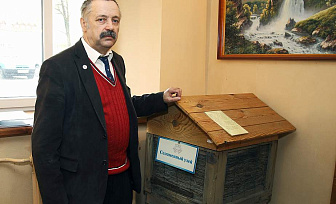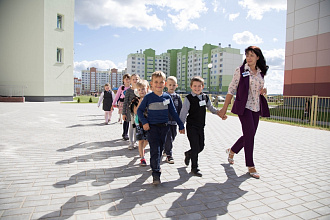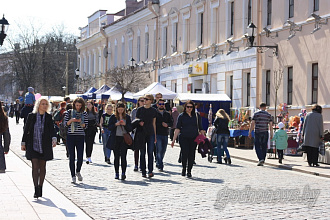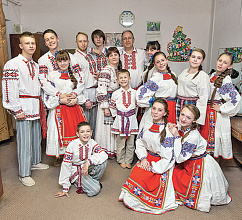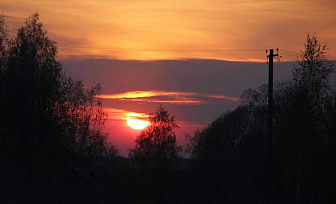The youngest republican wetland reserve "White Moss" in Grodno region was declared on an area of 887.55 hectares in the Ostrovets district in 2015. It was created to preserve valuable forest and swamp ecological systems, rare biotopes, populations of wild animals and valuable plants in their natural state, included in the Red Book of Belarus. The reserve is located in the Belarusian-Lithuanian borderland, therefore tourist routes do not pass through it, and you can get here only with a pass.
Upper swamp, forest and its inhabitants
"White Moss" is considered the most prosperous nature reserve in the region: the entrance to outsiders is closed. The territory is inaccessible, it runs along the Belarusian-Lithuanian border itself, and therefore plants and animals feel like full owners here and are not stressed from meeting intruders. A special environmental regime operates both by law and by territorial location.

- Why the reserve is called "White Moss" is not difficult to guess, says Nikolay Solovey, the forester of the Kemelish forestry of the Ostrovets experimental forestry. In the middle of the forest, in the swamps - everywhere there are areas covered with a carpet of white-white moss - sphagnum. He is the chief architect of the raised bog and creates the bulk of the peat. A lot of cranberries grow on moss carpets.
Valuable biotopes were thoroughly investigated and studied by employees of the V.F. Kuprevich of the National Academy of Sciences and the Scientific and Practical Center of the National Academy of Sciences of Belarus for Bioresources. They identified sixteen types of biotopes in this territory, as well as three categories of especially valuable plant communities that have a high ecological value and serve as a reserve for wild plants and wild animals included in the Red Book of the Republic of Belarus.

Four species of wild-growing plants from the Red Data Book grow in the reserve: small-fruited cranberries, ovoid cache, unifolia pulp and common ram. Four species fall under the Convention on International Trade in Endangered Species of Wild Fauna and Flora, nine species need preventive protection.
Seven species of wild animals and birds, included in the Red Book of the Republic of Belarus, feel great on virgin territories: gray crane, perching owl, corncrake, white-tailed eagle, little nocturnal, northern leather jacket, brown bear. The reserve has also become home to twenty one species of birds with high European conservation status.
-This place is wild, deaf, says Malafiy Zubanov, a 95-year-old resident of Yasen. - There have always been many wolves in the swamps, which is why there were wolf pits. Few dared to go there, although boletus grew there apparently-invisibly. And everyone wondered: why in a similar pine forest the moss was light green, but here it was completely light, almost white.

Vera Molokhvey, the librarian of the Podolsk rural library who used to work as a chemistry teacher at a local school, is happy to "enlighten" us:
- Sphagnum is unusual moss, differs from other bryophytes not only in structure, but also in color. He puts on a light green outfit when he gets drunk. When it dries, it becomes discolored, whitens, and therefore is popularly known as "white moss".
The picturesque lake Medino with an area of five hectares, which is abundant in fish, adjoins the reserve.

ANCIENT ALIEN
There is an opinion that swamp waters should not be drunk: the sight of rusty water makes an unpleasant impression. But these concerns do not apply to the water of the raised bog. The presence of sphagnum makes it almost sterile.
Sphagnas are widespread throughout the globe, only in the middle zone there are 42 species, and in the world - more than 300. Many mosses are named after scientists, the names of some reflect special signs or colors, habitats. These perennials form tussocks on raised bogs - pillows of different sizes. Among the mosses there are also inhabitants of forests and meadows.
Sphagnas equally well tolerate both great dryness and a large amount of moisture, they absorb a huge amount of rainwater, no wonder the generic name comes from the Greek word "sphagnos" - sponge. By retaining moisture, the plant forms a sod with waterlogged soil. Just imagine: the water supply in a living plant is eight times its dry weight, which makes the thin, flexible stems too heavy in the absence of mechanical tissue. Therefore, sphagnum grow close to each other, forming carpets. And support each other, intertwining with twigs. This small moss is gradually replacing tall trees in vast territories, creating unique communities of plants, fungi and animals, forming swamps and maintaining the water balance on the planet.

It is also curious that the total length of its stem is more than 160 centimeters, and the average growth per year is less than a millimeter. Therefore, scientists estimate the age of the moss at about 2000 years!
It is popularly believed that where cranberries grow, moss is healing. But in fact, it is healing everywhere. There are few microorganisms in the world that sphagnum would be powerless against. Strong antimicrobial and bactericidal properties made him a favorite of traditional medicine: in the treatment of ulcers and wounds, acute intestinal diseases, rheumatism During wars, partisans escaped with moss as a dressing material; it replaced iodine. And by itself it is not susceptible to any diseases.

ARCHITECTURAL EXCLUSIVE
The Old Believer wooden church of the 18th century is surprisingly fit into the forest landscape - as if from a fairy tale. The combination of the Byzantine style with the features of the Vilna Baroque makes it unique. The rectangular temple is covered with a gable roof. The pediment of the main façade is triangular, with decorative herringbone cladding. The low side galleries give the appearance of the basilica to the temple. The unsewn walls are decorated with carved cornices. The threshold was originally designed - a gable roof on wooden cantilever supports with struts ...

The Trinity Old Believer Church - a unique example of wooden architecture - was built in the 18th century, and in 1910 it was rebuilt with the money of the Russian Empire.
The 95-year-old old believer Malafey Zubanov remembers the times when the church flourished, lived: the Stripish Old Believer community numbered up to seven hundred people.
Grandfather Malaf, as the locals call him, was born in the village of Yasen, like his father and grandfather. But he considers himself Russian: his ancient ancestors once left the northern Russian lands in search of a land where they would not be persecuted for crossing themselves with two fingers instead of three. By what means the clan got to the Ostrovetchina, the villager does not know. Former history teacher of local history Vladimir Ostapets, who studied this topic in the seventies of the last century, says that the ancestors of the Old Believers came from Vetka - from there, at the request of the Russian Empire, they were driven away even during the Commonwealth.

The Old Believer church operated until the death of the last local abbot in the 70s of the last century, then for some time visiting priests conducted services on Sundays and holidays, and in the 90s the community was divided by the state border between Belarus and Lithuania. Over time, the farmsteads of the Old Believers became empty, and the church also became empty. In 2017, the border strip, inside which there were no residents left, was fenced off with a high fence, so that without the employees of the Ostrovets frontier post, now you cannot get there. And the wooden Trinity Church of the Old Believers in the Stripishki tract received the status of a historical and cultural monument of the third category.
In addition to the republican nature reserves "Sarochanskie lakes" and "White moss", there are two landscape reserves of local importance on the territory of the Ostrovets district. The regional landscape reserve "Lake Byk" is one of the deepest and most mysterious lakes in Belarus. It is not visited because it is located in the border strip.
Legend says that here the owner of the bull, who plowed the land on the feast of the Resurrection of Christ, was overtaken by God's punishment. And in the place where the earth opened up, a lake appeared, which amazes with the pristine nature along the banks. A school forestry was created on the basis of the Kotlovsky forestry. Students conduct their own research and thoroughly study the ecosystem of the reserve.
And the landscape geomorphological reserve "Sergeants" was created at the suggestion of the Institute of Geological Sciences of the National Academy of Sciences of Belarus near the villages of Palushi, Zadvorniki, and the farm of Sergeants. This is a reference glacier complex.

Time and events have left on the Ostrovets land the most unique monuments of nature and history, which delight and amaze, make it possible to feel part of this beauty, to feel the power of your own roots. Without exaggeration, it takes your breath away when you see these beautiful lakes, white mosses, untouched forests, majestic temples. They are the main gift we received from our ancestors, and the most important thing that we will pass on to new generations unchanged.


https://grodnonews.by









